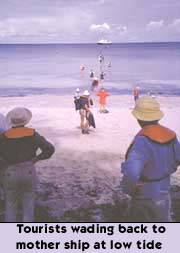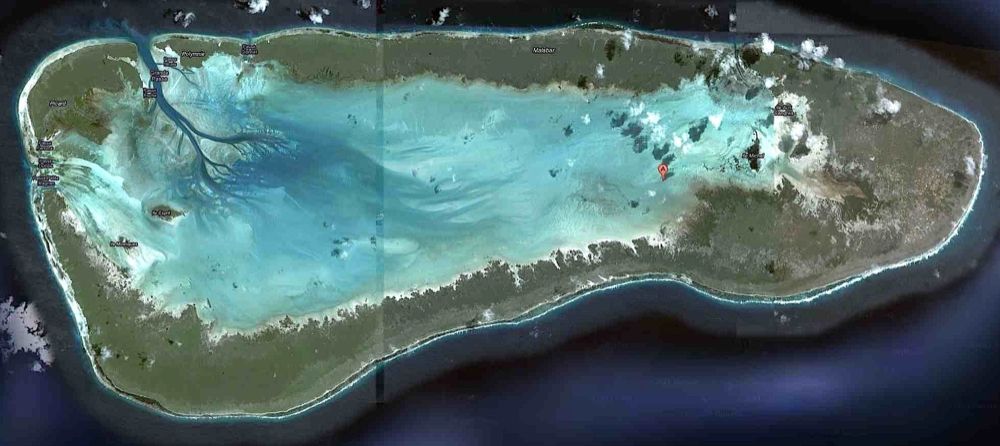 Aldabra
is actually an atoll of four islands forming the southernmost part of
the
Seychelles. With its elevated limestone reefs, vegetation and wild life
that has remained comparatively undisturbed by man, Aldabra is
unique.
Aldabra
is actually an atoll of four islands forming the southernmost part of
the
Seychelles. With its elevated limestone reefs, vegetation and wild life
that has remained comparatively undisturbed by man, Aldabra is
unique.
 Aldabra
is actually an atoll of four islands forming the southernmost part of
the
Seychelles. With its elevated limestone reefs, vegetation and wild life
that has remained comparatively undisturbed by man, Aldabra is
unique.
Aldabra
is actually an atoll of four islands forming the southernmost part of
the
Seychelles. With its elevated limestone reefs, vegetation and wild life
that has remained comparatively undisturbed by man, Aldabra is
unique.
It is also extremely difficult, unless one is a scientist on an approved project, to visit. And even scientists' visits are governed by the schedule of the government supply boat that makes the four day journey every three months from Mahe, the Seychelles capital, to this lonely, desolate outpost.
The passengers on board the Caledonian Star cruise ship were aware of the privilege of being able to visit Aldabra. That's what they were paying for, and the ship was making a contribution to the Seychelles Island Foundation which is responsible for Aldabra.
Many of the ship's passengers were amateur naturalists, interested in Aldabra's bird life. They stormed ashore from the fleet of rubber dinghies, armed with binoculars and water bottles. Heedless of the scorching sun, they trecked with determination into the interior scrub to try to catch sight of rare birds like the sacred ibis and the white-throated rail. The birds on Aldabra are of interest because they all arrived there by natural means, and were not introduced by man.
Lesser experts, such as myself, found Aldabra fascinating for its magnificent population of giant tortoises. Because it is the dominant animal in Aldabra, and herbivorous instead of carnivorous as in most terrestrial ecosystems, the giant tortoise and the way it lives, feeds, reproduces and regulates its population, is of great interest to biologists.
 Giant
tortoises are quite primitive reptiles; they evolved about 180 million
years ago. Now they are found in their natural habitat in only a few
islands
in the Indian and Pacific Oceans. There are over 150,000 giant
tortoises
on Aldabra, and only a handful of humans. Both kinds of animals seemed
interested in each other, the gentle giants sniffing the two legged
invaders
and seeming to pose while the tourists snapped souvenir
photographs.
Giant
tortoises are quite primitive reptiles; they evolved about 180 million
years ago. Now they are found in their natural habitat in only a few
islands
in the Indian and Pacific Oceans. There are over 150,000 giant
tortoises
on Aldabra, and only a handful of humans. Both kinds of animals seemed
interested in each other, the gentle giants sniffing the two legged
invaders
and seeming to pose while the tourists snapped souvenir
photographs.
Its inhospitable terrain and sparse fresh water supply has helped preserve Aldabra as a naturalist's haven, but it was not always so. To the Portuguese goes the credit of including the atoll first in a map in 1509. Settlers, and even pirates, kept away from the island until in 1814 it became part of the British colony of Mauritius. It probably irked the British adminstrators that such a large territory (60 square miles of land and a lagoon of 130 square miles) should serve no useful purpose and contribute no money to the exchequer. Leases were issued right up to 1955 for commercial exploitation of timber, green turtles, and fishing. But every attempt to exploit Aldabra's natural resources was, fortunately for nature- lovers, doomed to failure.
 In
1965 Aldabra and its population of tortoises became part of the British
Indian Ocean Territory and plans were advanced for it to become a
military
staging post. Led by the Royal Society of London a crusade was launched
against the establishment by environmentalists to save Aldabra's unique
flora and fauna from the encroachment of military technology.
In
1965 Aldabra and its population of tortoises became part of the British
Indian Ocean Territory and plans were advanced for it to become a
military
staging post. Led by the Royal Society of London a crusade was launched
against the establishment by environmentalists to save Aldabra's unique
flora and fauna from the encroachment of military technology.
The tortoises and their habitat were saved from extinction. In 1982, Aldabra became a UNESCO World Heritage Site and now it is one of the most intriguing ports of call for vessels in that part of the world, some 250 miles northwest of Madagascar and 400 miles east of the African coast.
Aldabra has no bars, no toilets, just scrubland and tortoises, with
scorpions and crabs and birds and rats and bats and other fauna to
photograph,
and the fantastic shapes of the eroded limestone reefs that pockmark
the
lagoon and lend the atoll a spooky quality. To complete the adventure
of
a visit to this strange, primeval atoll, the ship's passengers found,
when
they came to leave, that the tide had turned and the lagoon was too
shallow
for their motorised dinghies. They had to wade back through the lagoon
to the mother vessel. It was a sign that Aldabra intends to safeguard
its
isolation, enabling future generations to observe its curious flora and
fauna, saved form the indignity of mass tourism.
Travel Notes: The only way to reach Aldabra is by sea; private yachts have to obtain permission from the authorities in the Seychelles capital of Mahe before making the voyage. There is a once a week connecting flight from Colombo via Dubai to Seychelles.

